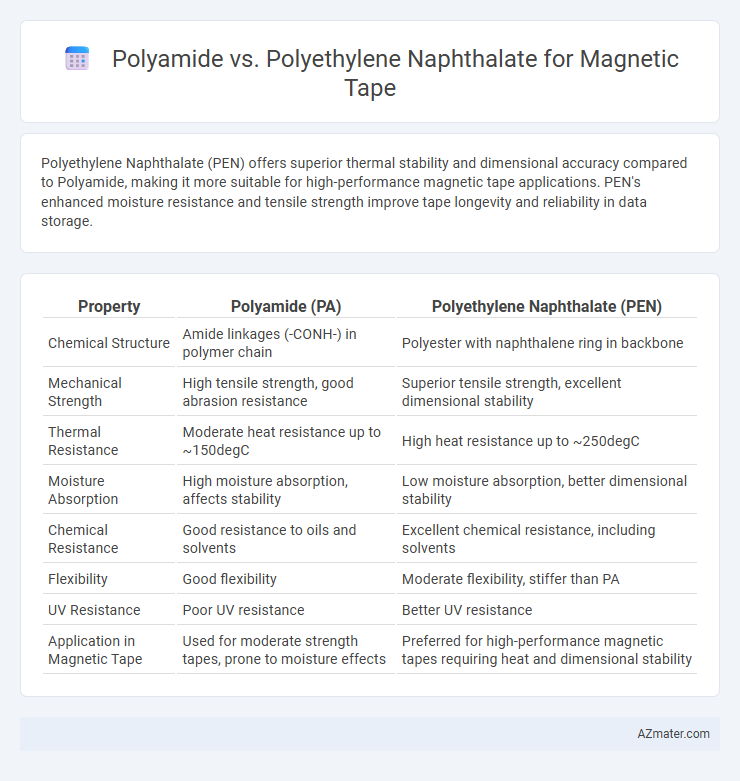Polyethylene Naphthalate (PEN) offers superior thermal stability and dimensional accuracy compared to Polyamide, making it more suitable for high-performance magnetic tape applications. PEN's enhanced moisture resistance and tensile strength improve tape longevity and reliability in data storage.
Table of Comparison
| Property | Polyamide (PA) | Polyethylene Naphthalate (PEN) |
|---|---|---|
| Chemical Structure | Amide linkages (-CONH-) in polymer chain | Polyester with naphthalene ring in backbone |
| Mechanical Strength | High tensile strength, good abrasion resistance | Superior tensile strength, excellent dimensional stability |
| Thermal Resistance | Moderate heat resistance up to ~150degC | High heat resistance up to ~250degC |
| Moisture Absorption | High moisture absorption, affects stability | Low moisture absorption, better dimensional stability |
| Chemical Resistance | Good resistance to oils and solvents | Excellent chemical resistance, including solvents |
| Flexibility | Good flexibility | Moderate flexibility, stiffer than PA |
| UV Resistance | Poor UV resistance | Better UV resistance |
| Application in Magnetic Tape | Used for moderate strength tapes, prone to moisture effects | Preferred for high-performance magnetic tapes requiring heat and dimensional stability |
Introduction to Magnetic Tape Materials
Polyamide and Polyethylene Naphthalate (PEN) serve as key substrates in magnetic tape manufacturing, each offering distinct mechanical and thermal properties critical to data storage reliability. Polyamide provides excellent flexibility and abrasion resistance, making it suitable for applications requiring durability and frequent handling. PEN exhibits superior thermal stability and dimensional accuracy, ensuring consistent magnetic performance and longevity under varying environmental conditions.
Overview of Polyamide in Magnetic Tape Applications
Polyamide in magnetic tape applications offers exceptional mechanical strength and thermal stability, essential for maintaining tape durability during high-speed recording and playback processes. Its excellent adhesion properties and resistance to wear enhance the longevity and reliability of magnetic tape media. Compared to Polyethylene Naphthalate, polyamide provides superior flexibility and impact resistance, making it suitable for demanding tape environments.
Polyethylene Naphthalate (PEN): Properties and Uses
Polyethylene Naphthalate (PEN) offers superior dimensional stability, higher thermal resistance, and enhanced mechanical strength compared to Polyamide, making it ideal for high-performance magnetic tape applications. PEN's excellent barrier properties and resistance to hydrolysis enable longer lifespan and reliability in data storage, especially in harsh environments. Used in advanced magnetic tapes, PEN ensures improved signal retention and durability essential for archival and industrial recording media.
Mechanical Strength: Polyamide vs Polyethylene Naphthalate
Polyamide offers high tensile strength and excellent abrasion resistance, making it suitable for magnetic tape applications requiring durability under mechanical stress. Polyethylene naphthalate (PEN) exhibits superior dimensional stability and higher modulus compared to polyamide, providing enhanced resistance to stretching and deformation. The mechanical strength of PEN generally surpasses polyamide, contributing to improved tape longevity and performance in demanding environments.
Thermal Stability Comparison
Polyamide exhibits moderate thermal stability with decomposition temperatures typically around 300degC, making it suitable for standard magnetic tape applications subjected to moderate heat. Polyethylene naphthalate (PEN) offers superior thermal stability, with a higher glass transition temperature near 120degC and melting point above 270degC, enabling better performance in high-temperature environments. This enhanced thermal resistance of PEN results in improved dimensional stability and durability in magnetic tape production exposed to elevated processing or operational temperatures.
Chemical Resistance in Tape Environments
Polyamide exhibits superior chemical resistance to oils, solvents, and alkaline substances commonly found in magnetic tape environments, ensuring enhanced durability and minimal degradation over time. Polyethylene Naphthalate (PEN) offers excellent resistance to moisture and UV exposure but is more susceptible to hydrolysis and certain chemical agents compared to polyamide. Selecting polyamide as the basefilm material improves tape longevity in harsh chemical conditions typically encountered during magnetic tape manufacturing and usage.
Dimensional Stability and Tape Longevity
Polyamide offers superior dimensional stability for magnetic tape due to its high mechanical strength and resistance to environmental stress, reducing tape deformation during use. Polyethylene naphthalate (PEN) excels in tape longevity, providing enhanced thermal stability and moisture resistance, which minimizes aging and preserves signal integrity over time. Choosing PEN improves long-term magnetic tape performance, while polyamide is advantageous where immediate mechanical durability and dimensional precision are critical.
Impact on Data Retention and Signal Quality
Polyamide offers superior mechanical strength and flexibility for magnetic tape, enhancing data retention by minimizing physical deformation during use. Polyethylene Naphthalate (PEN) provides exceptional dimensional stability and thermal resistance, which significantly improves signal quality by maintaining consistent tape tension and reducing noise. The choice between polyamide and PEN fundamentally affects long-term data integrity and playback precision through their distinct impacts on tape durability and signal fidelity.
Cost-Effectiveness and Availability
Polyamide offers moderate cost-efficiency and widespread availability, making it a common choice for magnetic tape backing due to its durability and heat resistance. Polyethylene naphthalate (PEN) provides superior dimensional stability and chemical resistance but generally comes at a higher cost and limited suppliers. When balancing budget constraints and performance requirements, polyamide remains more accessible, while PEN is preferred for high-performance applications despite its premium price.
Choosing the Right Material for Magnetic Tape
Polyamide offers superior mechanical strength and flexibility, making it ideal for high-durability magnetic tapes used in critical data storage applications. Polyethylene Naphthalate (PEN) provides excellent dimensional stability and chemical resistance, ensuring reliable performance in environments with temperature fluctuations and exposure to solvents. Selecting the right material depends on balancing the need for durability, thermal stability, and overall tape longevity specific to the intended use case.

Infographic: Polyamide vs Polyethylene Naphthalate for Magnetic Tape
 azmater.com
azmater.com